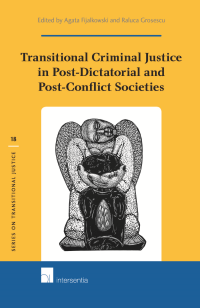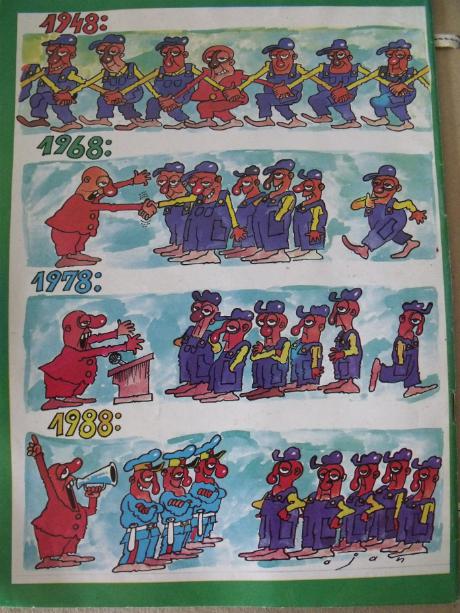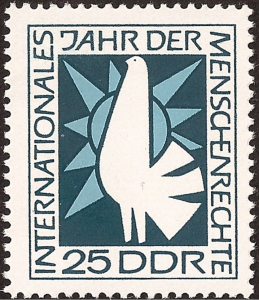Global Socialism and Post Socialism Workshop Report
Posted on 8 July, 2015 in1989 after 1989 Globalisation Post Socialism Rethinking 1989 Socialism

Held May 13, 2015 at The University of Exeter
Report by James Mark, Nelly Bekus, Anna Calori, Raluca Grosecu, Ned Richardson-Little, and Ljubica Spaskovska
While the topic of globalization has emerged as rapidly growing field in recent years, the role of the socialist world is often neglected or seen as passive or unengaged in these processes. This workshop, hosted by 1989 after 1989: Rethinking the Fall of State Socialism in Global Perspective research group, sought to challenge these narratives by examining the myriad engagements of the socialist world with the global. The presentations proposed new methodological and theoretical means of grappling with how late socialism fits into the larger narrative of globalization, examined the spaces in which processes of globalization occurred in the socialist world, and analyzed the long-term effects of these developments after 1989 and the collapse of state-socialism.
 Tobias Rupprecht (University of Exeter) opened the first panel – Approaches to Globalisation and The Socialist World – providing a broad introduction to the themes of the workshop. He explored how current literature on globalisation is still often shaped by the values of the 1990s, and how, within this, the socialist world is most commonly presented simply as a victim of globalising forces. He then demonstrated the various ways in which the socialist world provided templates for ‘alternative globalisations’, and also acted as co-producer of some of the aspects of the globalised world we experience today.
Tobias Rupprecht (University of Exeter) opened the first panel – Approaches to Globalisation and The Socialist World – providing a broad introduction to the themes of the workshop. He explored how current literature on globalisation is still often shaped by the values of the 1990s, and how, within this, the socialist world is most commonly presented simply as a victim of globalising forces. He then demonstrated the various ways in which the socialist world provided templates for ‘alternative globalisations’, and also acted as co-producer of some of the aspects of the globalised world we experience today.
 Bogdan Iacob (New Europe College, Bucharest) presentation – Negotiating the National. Romania, Globalization, and International Congresses of Historical Sciences (1970-1980) – analysed the responses of the Romanian socialist government to the rising web of interdependencies in 1970s, which would come to be known as globalization in the next decade. He then tested the implementation of this position for the case of the country’s engagement with International Congresses of Historical Sciences, particularly those between 1970 and 1980 – in Moscow, San Francisco, and Bucharest. Focusing on the Bucharest conference of 1980, the Iacob argued that one can identify a dichotomous approach to globalization in the case of Romania. On the one hand, the country was fully engaged with supra-, inter-, and non- governmental institutions during the global Cold War. On the other hand, the internationalization of Romanian state socialism also meant showcasing components of local modernity. The presentation underlined that the Romanian case of socialism going global is a cautionary tale. It is the story of a regime engrossed in the global encounters of the 1960s and 1970s that reaches, in 1980s, a final phase of systemic insulation and exacerbated essentialism. For the local, state socialist globalization ultimately meant carving pericentric frameworks highly dependent into very specific Cold War contexts.
Bogdan Iacob (New Europe College, Bucharest) presentation – Negotiating the National. Romania, Globalization, and International Congresses of Historical Sciences (1970-1980) – analysed the responses of the Romanian socialist government to the rising web of interdependencies in 1970s, which would come to be known as globalization in the next decade. He then tested the implementation of this position for the case of the country’s engagement with International Congresses of Historical Sciences, particularly those between 1970 and 1980 – in Moscow, San Francisco, and Bucharest. Focusing on the Bucharest conference of 1980, the Iacob argued that one can identify a dichotomous approach to globalization in the case of Romania. On the one hand, the country was fully engaged with supra-, inter-, and non- governmental institutions during the global Cold War. On the other hand, the internationalization of Romanian state socialism also meant showcasing components of local modernity. The presentation underlined that the Romanian case of socialism going global is a cautionary tale. It is the story of a regime engrossed in the global encounters of the 1960s and 1970s that reaches, in 1980s, a final phase of systemic insulation and exacerbated essentialism. For the local, state socialist globalization ultimately meant carving pericentric frameworks highly dependent into very specific Cold War contexts.
The second panel – The Socialist World, Trade, and Globalisation – began with James Mark’s  (University of Exeter) presentation, “Between the Eastern Bloc and the East Asian ‘Tigers’: The Opening Up between Hungary and South Korea 1970-1995.” Mark used the opening up between Hungary and South Korea to explore the ways in which experts in a socialist state imagined the operation of the world economy in the late Cold War. He showed how reform economists in Hungary, influenced by World Systems Theory, re-imagined their country’s role in the world economy as semi-peripheral. This then led them to an interest in the Asian “Tigers” as examples of successful integration into the world economy by formerly semi-peripheral countries. He explored these experts’ new prescriptions for the Hungarian economy from this perspective, and the fascination with South Korea amongst political and economic elites in the last years of state socialism.
(University of Exeter) presentation, “Between the Eastern Bloc and the East Asian ‘Tigers’: The Opening Up between Hungary and South Korea 1970-1995.” Mark used the opening up between Hungary and South Korea to explore the ways in which experts in a socialist state imagined the operation of the world economy in the late Cold War. He showed how reform economists in Hungary, influenced by World Systems Theory, re-imagined their country’s role in the world economy as semi-peripheral. This then led them to an interest in the Asian “Tigers” as examples of successful integration into the world economy by formerly semi-peripheral countries. He explored these experts’ new prescriptions for the Hungarian economy from this perspective, and the fascination with South Korea amongst political and economic elites in the last years of state socialism.
With his presentation, “Trading Internationalism: Rethinking Cold War Narratives through Sino-Middle East Relations, 1950s-70s,” Sam Zhiguang (University of Exeter) challenged the idea that international trade should be conceptualized solely in terms of commercial value. He argued that both Western economic models of comparative advantage or concepts such as Socialist division of labour did not capture the ideological and cultural meaning of trade in the People’s Republic of China during the Cold War. According to Chinese doctrine, establishing international unity was essential to national unity. One of the key means of fostering solidarity with the Third World was through the exchange of trade delegations. Through the lens of Sino-Middle East relations, he contended that while these exchanges did not often lead to significant commercial activity, this was not their primary goal. Chinese enthusiasm for engagement with the Middle East was not motivated by profit, but a more complex ideological understanding of global unity as a proxy for the wellbeing of China itself under Communist rule.
Anna Calori’s (PhD student, University of Exeter) presentation titled “Privatisation Reforms and the Global Market: Fragmenting the Workforce in Late-Socialist Bosnia-Hercegovina” explored the rationale behind the late 1980s economic reforms in Yugoslavia and their disruptive effects within the workplace of large, exporting companies. Engaging with primary sources such as factory bulletins and internal journals, Calori provided an analysis of discourses and debates around what was presented as a necessary change in the Yugoslav economic model of workers’ self-management. Responses to the urgencies of competitiveness on the global market meant a re-conceptualisation of the (post) socialist worker based on new exclusionary categories of merit and efficiency. This deeply affected the industrial workplace, exacerbating the already existing skills divisions and allowing for a further fragmentation of the workforce in the critical moments leading to Yugoslavia’s disruption.
Calori’s (PhD student, University of Exeter) presentation titled “Privatisation Reforms and the Global Market: Fragmenting the Workforce in Late-Socialist Bosnia-Hercegovina” explored the rationale behind the late 1980s economic reforms in Yugoslavia and their disruptive effects within the workplace of large, exporting companies. Engaging with primary sources such as factory bulletins and internal journals, Calori provided an analysis of discourses and debates around what was presented as a necessary change in the Yugoslav economic model of workers’ self-management. Responses to the urgencies of competitiveness on the global market meant a re-conceptualisation of the (post) socialist worker based on new exclusionary categories of merit and efficiency. This deeply affected the industrial workplace, exacerbating the already existing skills divisions and allowing for a further fragmentation of the workforce in the critical moments leading to Yugoslavia’s disruption.
 In the third panel, “Spaces of Globalisation in Eastern Europe” Ljubica Spaskovska (University of Exeter) examined “Socialist global citizenship: the case of Yugoslavia.” Spaskovska’s presentation addressed a range of “spaces” of global encounters and cooperation through the lens of “global citizenship.” In different ways related to the United Nations, the Non Aligned Movement, the International Centre for Public Enterprises in Developing Countries and the post-1963 earthquake development plan for Skopje were some of those spaces of global citizenship where ideas that revolved around (equitable) development, anti-colonialism, fairer terms of trade and fostering ‘active peaceful coexistence’ gained ground. Socialist Yugoslavia’s “globally imagined citizenship” was a chartered foreign policy course that produced an impressive record of economic, intellectual and cultural exchange and enabled the country to vie for influence and recognition in a divided world. Although often discordant, the Non Aligned Movement managed to carve out alternative spaces and put forward novel development agendas and paradigms of international cooperation.
In the third panel, “Spaces of Globalisation in Eastern Europe” Ljubica Spaskovska (University of Exeter) examined “Socialist global citizenship: the case of Yugoslavia.” Spaskovska’s presentation addressed a range of “spaces” of global encounters and cooperation through the lens of “global citizenship.” In different ways related to the United Nations, the Non Aligned Movement, the International Centre for Public Enterprises in Developing Countries and the post-1963 earthquake development plan for Skopje were some of those spaces of global citizenship where ideas that revolved around (equitable) development, anti-colonialism, fairer terms of trade and fostering ‘active peaceful coexistence’ gained ground. Socialist Yugoslavia’s “globally imagined citizenship” was a chartered foreign policy course that produced an impressive record of economic, intellectual and cultural exchange and enabled the country to vie for influence and recognition in a divided world. Although often discordant, the Non Aligned Movement managed to carve out alternative spaces and put forward novel development agendas and paradigms of international cooperation.
 In Ned Richardson-Little’s (University of Exeter) paper “Where the World Meets”: Globalization and Socialism at the Leipzig Trade Fair,” he examined the paradoxes of East Germany’s engagement with the world through the lens of famous Leipziger Messe. While the trade fair was supposed to serve as a site of cooperation fostering East-West understanding and exchange between “the two world systems,” it was also to serve as the “show-window of socialism” and demonstrate the superiority of the Socialist Bloc over its Western counterparts. The Trade Fair initially acted as a proxy site of diplomatic and cultural contact with the world while East Germany remained diplomatically unrecognized outside the Socialist Bloc. Later, the Trade Fair acted as a crucial venue for GDR efforts to integrate into the modernizing global economy in the 1970s and 1980s through joint ventures with the West and Third World export deals. While the Trade Fair was a gateway to the benefits of globalization, it was also a site of dangerously uncontrolled contact for East Germans to the outside world, which contributed to the political destabilization of the 1980s.
In Ned Richardson-Little’s (University of Exeter) paper “Where the World Meets”: Globalization and Socialism at the Leipzig Trade Fair,” he examined the paradoxes of East Germany’s engagement with the world through the lens of famous Leipziger Messe. While the trade fair was supposed to serve as a site of cooperation fostering East-West understanding and exchange between “the two world systems,” it was also to serve as the “show-window of socialism” and demonstrate the superiority of the Socialist Bloc over its Western counterparts. The Trade Fair initially acted as a proxy site of diplomatic and cultural contact with the world while East Germany remained diplomatically unrecognized outside the Socialist Bloc. Later, the Trade Fair acted as a crucial venue for GDR efforts to integrate into the modernizing global economy in the 1970s and 1980s through joint ventures with the West and Third World export deals. While the Trade Fair was a gateway to the benefits of globalization, it was also a site of dangerously uncontrolled contact for East Germans to the outside world, which contributed to the political destabilization of the 1980s.
 The fourth panel on “Global Socialism and Its Legacies” began with Raluca Grosescu (University of Exeter) presenting on “International Criminal Law Before and After 1989: The Case of the UN Convention on the Non-Applicability of Statutory Limitations to War Crimes and Crimes against Humanity.” Grosescu examined the role of state-socialist countries in the development of international criminal law, through the example of the 1968 UN Convention on the Non-Applicability of Statutory Limitations to War Crimes and Crimes against Humanity. She examined the context, the negotiations, and the interpretations that had been given to the Convention in 1968 and then focused on the Convention’s application and its new readings in domestic prosecutions of human rights abuses in Argentina and Estonia in the 2000s. Grosescu argued that international criminal law norms initiated or supported by state-socialist countries during the Cold War have been highly instrumental in trials dealing with crimes of authoritarian regimes during the “third-wave of democratization” in Latin America and Eastern Europe. The presentation also reflected on the historicity of law by examining how legal norms constructed in a particular historical context with a specific political purpose are re-interpreted and re-negotiated in order to fulfil new political goals in the present.
The fourth panel on “Global Socialism and Its Legacies” began with Raluca Grosescu (University of Exeter) presenting on “International Criminal Law Before and After 1989: The Case of the UN Convention on the Non-Applicability of Statutory Limitations to War Crimes and Crimes against Humanity.” Grosescu examined the role of state-socialist countries in the development of international criminal law, through the example of the 1968 UN Convention on the Non-Applicability of Statutory Limitations to War Crimes and Crimes against Humanity. She examined the context, the negotiations, and the interpretations that had been given to the Convention in 1968 and then focused on the Convention’s application and its new readings in domestic prosecutions of human rights abuses in Argentina and Estonia in the 2000s. Grosescu argued that international criminal law norms initiated or supported by state-socialist countries during the Cold War have been highly instrumental in trials dealing with crimes of authoritarian regimes during the “third-wave of democratization” in Latin America and Eastern Europe. The presentation also reflected on the historicity of law by examining how legal norms constructed in a particular historical context with a specific political purpose are re-interpreted and re-negotiated in order to fulfil new political goals in the present.
 In her presentation on “Soviet Frames of Global Experience in Architecture, Before and After 1989,” Nelly Bekus (University of Exeter) argued that both architecture and urban planning were considered to be a powerful instrument in cold war politics. The presentation examined the specific frameworks of the concept of Soviet internationalism, which mentally mapped the world beyond the ideological blocs. Specific educational and professional conditions and practices elaborated for architects in the USSR meant to produce such mental representation of the Soviet Union territory that made it fully operational and sufficient for self-perception of Sovietness as a form of global identity. Bekus also discussed International Architectural Design competitions as a space of global engagement of architects beyond the Soviet borders. These competitions often served as stages of “global professionalism” for architects and in which Soviet participants could claim their part.
In her presentation on “Soviet Frames of Global Experience in Architecture, Before and After 1989,” Nelly Bekus (University of Exeter) argued that both architecture and urban planning were considered to be a powerful instrument in cold war politics. The presentation examined the specific frameworks of the concept of Soviet internationalism, which mentally mapped the world beyond the ideological blocs. Specific educational and professional conditions and practices elaborated for architects in the USSR meant to produce such mental representation of the Soviet Union territory that made it fully operational and sufficient for self-perception of Sovietness as a form of global identity. Bekus also discussed International Architectural Design competitions as a space of global engagement of architects beyond the Soviet borders. These competitions often served as stages of “global professionalism” for architects and in which Soviet participants could claim their part.
In opening the concluding discussion, Angela Romano (University of Glasgow) underlined the importance of combining a micro- and a macro perspective, which would in turn shed light on the range of networks and the contribution of the socialist world to the processes of globalisation. She emphasized the importance of re-integrating 1989 into the study of the alternative spaces of globalization – not necessarily as a turning point, but as an opening for the debate about different forms and practices of global engagements that shaped both the socialist and the post-socialist world.
Workshop Overview
Panel 1: Approaches to Globalisation and The Socialist World
Dr Tobias Rupprecht (Exeter), The ‘Socialist World’ and ‘Global History’
Bogdan C. Iacob (New Europe College, Bucharest), Politics of National Identity as Mechanism of Globalizing Late State Socialism
Panel 2: The Socialist World, Trade, and Globalisation
Professor James Mark (Exeter), Between the Eastern Bloc and the east Asian ‘Tigers’: The Opening Up between Hungary and South Korea 1970-1995
Dr Sam Zhiguang (Exeter), Trading Internationalism: Rethinking Cold War Narratives through Sino-Middle East Relations, 1950s-70s
Anna Calori (PhD, Exeter), Privatisation reforms and the global market: fragmenting the workforce in late-socialist Bosnia-Hercegovina
Panel 3: Spaces of Globalisation in Eastern Europe
Dr Ljubica Spaskovska (Exeter), Socialist Global Citizenship: The Case of Yugoslavia
Dr Ned Richardson-Little (Exeter), “Where the World Meets”: Globalization and Socialism at the Leipzig Trade Fair
Panel 4: Global Socialism and Its Legacies
Dr Raluca Grosescu (Exeter) International Criminal Law Before and After 1989: The Case of the 1968 UN Convention on War Crimes and Crimes against Humanity
Dr Nelly Bekus (Exeter) Soviet Frames of Global Experience in Architecture, Before and After 1989
Concluding Discussion
with comments from Dr Angela Romano (University of Glasgow)
Workshop on Global Socialism and Post Socialism
Posted on 13 April, 2015 in1989 after 1989 Socialism

13 May 2015
The University of Exeter, Amory A239AB
Time: 9am – 6.15pm
All are welcome to attend our workshop on Global Socialism and Post Socialism which will be held on Wednesday 13 May, 2015 here at the University of Exeter. The theme of the one day workshop will be global socialism/ post-socialism and will include papers from the 1989 after 1989 Research Team and a number of invited speakers.
Papers will cover: re-conceptualising globalisation and the socialist world; the encounter between eastern Europe and the east Asian ‘tigers’ in the late Cold War; eastern European trade fairs as sites of global encounter in the Cold War; China and the idea of trade with ‘Third World’ and Yugoslavia and African engagements.
For more information about this event and to see the programme for the day please visit our Workshops page.
[Top]Minsk as a Townscape of The Belarusian Power
Posted on 25 February, 2015 in1989 after 1989 Post-Soviet Cities

By Nelly Bekus
Cityscape of Minsk embodies the imaginary environment of the Belarusian power as a legitimate successor of the socialist state.
“If Soviet cities had looked like Minsk today, Soviet Union would have survived,” is probably one of the most indicative opinions I’ve ever heard from the visitors of the Belarusian capital. It is rather problematic to say to which extent it captures the hypothetical fortune of the Soviet state, but what it certainly does is reveal aspirations that inform the capital formative politics of the Belarusian leadership.
Any state can be viewed as a performative collective actor, which both reproduces and has been reproduced through banal processes, which enforce the symbolic presence of state across all kinds of social practices and relations and which help to sustain connection between the state and the people via the concept of belonging. Any capital city is assigned a particular role in displaying and channeling the nation’s image and idea. Yet, in country like Belarus the pressure on capital’s symbolic importance not even doubles, but triples. The country’s newborn national statehood, its centralized political system, and its vastly meaningful socialist legacy, material and non-material alike, facilitate maintaining the hegemony of power in various spheres of peoples’ life. Belarus turned to be particularly apt to preserve and develop the Soviet pattern of the symbolic-ideological design of state, reproducing the matrix of the “spectacular state” in the nationstate framework. A wide range of various civil rituals and social practices has been developed on the micro- and macro-levels of everyday life of the Belarusians, which aim at symbolic reification of the Belarusian idea, as understood by ideologists. Minsk, no doubt, has been assigned a particular role in the performative strategy of the Belarusian state.
Favourable National Framework for the Socialist Legacy
After the failure of state socialism the capital cities of the new independent states had to formulate new principles of their urban development. For many countries, the model to follow became the “Western city,” as an attribute of European civilization, the winner of the Cold War. The consequences of cities’ development in that direction (socio-spatial stratification, suburbanization, gentrification, automobilization, etc.) were perceived as natural and even desirable products of the changing pattern of urbanism. The socialist legacy of cities associated with the outdated system came to be perceived as unwanted inheritance. Micro-districts that once embodied the idea of egalitarian society have now become the most decaying areas in cities.
Against this background, Minsk appears to be a rare exception. The status granted to its socialist legacy in the new national cityscape and the logic of its cooperation with the nation-state ideology puts Belarus outside of Eastern European liberal affinity. The primary metaphor of the Belarusian official discourse defining post-communism has become the idea of a seamless continuation of the Soviet tradition. From the beginning of his presidency, the Belarusian President A. Lukashenko has chosen strategy of exploiting the nostalgic feelings of one part of Belarusian society, and he did so for a good reason. The last decade of the state socialism often depicted as “Soviet decay” seemed contrary to the lived experience of most Belarusians. It was not stagnation, but the years of rapid economic development and improvement of the lifestyle of the majority.
Minsk as a Soviet Artefact
The major structural changes in Belarus took place after the Second World War. Minsk as the capital of the Republic of Belarus was also the product of Soviet vintage. Minsk experienced massive destruction during the Second World War, it was the third most demolished city after Berlin and Warsaw. 80% of city infrastructure and 70% of pre-war housing stock of the city were destroyed.
According to the conception of master plan of Minsk (1946), new city was designed to combine the image of a “true capital of the Soviet Socialist republics” with the function of a large industrial center. The combination of striking parade monumentalism, patriotic art decoration and traditional motifs has become the most characteristic feature of the central avenues of Minsk. In late 1950s, when quasi-pragmatic period of socialist architecture had begun with its shift to the wide use of standardized construction, the center of Minsk had been surrounded by a belt of simplistic buildings made of pre-fabricated concrete, gradually passing into the clone-like “sleeping areas” of late socialism. The image of city soon became dominated by buildings that provided modest accessible housing for everybody due to a rapid construction of classless neighborhoods.
In the 1960s, when the construction of the monumental image of the city center was almost complete, Soviet authorities undertook an action for the ideological design of Minsk. A mythology of the partisan movement as the specific “Belarusian” contribution to a common victory in the Great Patriotic War became a key element of the Soviet Belarusian historical narrative, immediately reflected in a corresponding symbolization of public spaces in Minsk. The status of “Hero City” was given to Minsk in 1974. In addition, several important monuments were dedicated to World War II: Victory square with the eternal flame in front of the obelisk in the city center; Yama Memorial (the Ditch), dedicated to the commemoration of 800 000 Belarusian Jews—victims of the Holocaust; and a memorial on the site of the Nazi concentration camp Trastsianets. The Belarusian Great Patriotic War Museum in Minsk became the first museum in Belarus, opened in 1944, even before the war was over. In 1966 it was relocated to Oktiabrskaya Square, next to the building of the Central Committee of Communist Party of BSSR (the Presidential Palace since 1994).
The mythology so attentively composed by Soviet ideologists for Belarusians outlived the Soviet state itself. It became a key element of the national narrative about heroic collective deeds. In contrast to the Soviet narrative, the new discourse nationalizes the Belarusians’ heroic fight against the Nazi occupiers during World War II. The emphasis has been put not on the fraternal struggle of Soviet people against invaders, but on the Belarusians’ effort in liberation of their land. In a similar fashion, the general perception of Sovietness has been “Belarussified.”The Soviet period is now described as a period of formation of the contemporary Belarusian nation.
The Soviet legacy, solidified and materialized in the center of Minsk, appears to be a fairly relevant reflection of the official view on the formation of the Belarusian nation. The Sovietness of Minsk’s city center has the same functional meaning of “historical heritage” that all European countries invest in their capitals. In old European cities the preservation of the historical center has meant the creation of a kind of reservoir of national cultural tradition, molded into architectural form. The history encoded in the architectural monumentality of the Stalinesque center of Minsk refers to the Soviet era, but it has been attributed the same symbolic meaning. In 2004, Belarusian authorities nominated Minsk’s central avenue for inclusion on the UNESCO World Heritage List (avenue’s name in Soviet times— Stalin Avenue, from 1961—Lenin Avenue, from 1991—Frantishak Skaryna Avenue, and, finally, since 2004 till present time—Independence Avenue). The cultural legacy, represented by the remarkably solid and stylistically homogeneous urban architectural ensemble of central Minsk, has been presented as evidence of the Soviet contribution to the formation of the Belarusian nation. In the spirit of this memory politics, not only have all Soviet monuments kept their place and symbolic meaning in Minsk’s public space (including the Lenin statue on Independence Square) but new monuments commemorating events and characters related to the Soviet past have also been built during the years since independence. A Feliks Dzierzhinski statue was installed in Minsk in 2006—a memorial to the founder of the Soviet NKVD, though there was a Dzierzhinsky monument in Minsk, built in the Soviet era near Independence Avenue. Several new monuments were built on the wave of the nationalization of the memory of World War II, such as the “Belarus Partizanskaya” (Partisan Belarus) monument that was built in 2004, and the memorial “Broken Hearth” dedicated to the memory of the victims of Nazism. New museum of the Great Patriotic War was opened in Minsk in 2014, which proposed a new version of the official war narrative, centered on Belarusians and their combined image of great victimhood and heroism.
The Ideological Concept and a Slight Shift
The symbolic domination of the Soviet legacy in the Minsk cityscape proves to be very consistent with the ideological concept of Belarus promoted by ruling elites. In those post-Soviet countries that developed liberal political regimes, any changes in the symbolic landscape of the capital cities reflect the struggle among the political elites for the “symbolic capital” embodied in and represented by places of memory (P. Bourdieu 1990). In Belarus, however, such a period of open contestation over the symbolic landscape of Minsk lasted only for four years from 1991 to 1994, and the changes made then did not affect the city’s existing monuments, though some changes did take place in the toponyms of Minsk. Although these changes were rather limited in scale (only 14 streets were renamed), they did affect key streets in the city center, effectively making visible the nationalization of the capital: the central Lenin Avenue was renamed after the leading Belarusian Renaissance scholar and humanist Francisk Skaryna, Lenin Square became Independence Square and Gorki (Russian writer) Street became Bagdanovich (Belarusian poet) Street. The Belarusian president corrected some of these changes in 2004, when he personally made a decision to rename two main thoroughfares, Skaryna Avenue and Praspekt Masherava as Independence Avenue and Avenue of the Victors. These changes were meant to indicate the authorities’ attention to the 60th anniversary of Victory Day in World War II and state independence, once again reasserting the role of war memory for national narrative of Belarus.
The political design of the Belarusian state that was established and has been successfully maintained by the incumbent president since 1994 does not allow for any alternative sources of power that could visibly affect the symbolic landscape of the Belarusian capital. Oppositional elites, deprived of any possibilities for influencing the cityscape, have very few instruments of symbolic resistance at their disposal. One avenue that is open to them is the use of educational historical initiatives, proposed by oppositional educational centers or individual historians. The weekly newspaper Nasha Niva regularly puts out information about“alternative” historical tours of Minsk, that have been created by oppositional historians as an alternative way to see Minsk and the history of Belarus (Addresses of Belarusian People’s Republic). Certainly, these kinds of educational and cultural initiatives cannot compete with the state machine’s work on the official ideological landscape of the city through the visual design of public spaces, monuments, and posters, as well as official mass events, etc.
In the 2000s, a slight shift in the ideological reading of the Soviet legacy could be noticed in the development of the capital cityscape. From presenting Sovietness as a period of significant Belarusian achievement it has moved to the idea of Soviet past as the foundation of an independent Belarusian state and one of the origins of its successes. New symbols of Belarusian independence have been constructed with the specific goal of demonstrating the successes of the current regime. Among them was the new modern railroad station (2004), the new National Library which quickly became an icon of the new Belarus (2006), and a three-level underground shopping mall, “The Capital”, situated under Independence Square (2007), which significantly transformed the function of the former Soviet city center by adding to it a consumerist attraction. Representative monumentality of Soviet Minsk was supplemented with a new icon of post-Soviet hegemonic power—the Palace of Independence (2013), adjacent to State Flag Square, with clear intention to emphasize the firmness of the Belarusian statehood.
At the same time, authorities became more attentive to the pre-Soviet history of Minsk: some destroyed fragments of pre-revolutionary Minsk were reconstructed, such as the 19th century town hall building, the Hotel Europe, and some others. This new development of the capital was backed by the ambitions of the president to make Belarus and its capital city a touristic attraction. “European” legacy in the Belarusian context, however, is not restored in order to return the country symbolically to Europe, but, on the contrary, to authorize Belarusian geopolitical choices by showing that “Europe” exists “inside” Belarus, therefore, there is not much need for Europe existing behind the western border.
New sport arenas and new hotels (Hotel Europe, Crowne Plaza) were constructed in order to prepare for the 2014 IIHF Ice Hockey World Championship. This event was unconditionally perceived by the authorities as a chance to demonstrate to the international community the achievements and successes of the country’s “third way” of development.
One of the elements of this third way is related to the ongoing tradition of constructing new residential areas—microdistricts—on the outskirts of Minsk. In most of the former socialist countries, system change meant a radical break with the image-making panel houses constructed in the city. In Belarus, on contrary, the housing policy preserved orientation towards the construction of state-subsidized affordable housing for people. As a result, new residential areas on the outskirts of Minsk have been constructed in the same manner of microdistricts, i.e. more or less compact settlements, comprised of uniform blocks of flats along with associated services (educational, health, retail and cultural services), clearly reproducing the pattern of socialist urbanism.
This architectural continuation of the socialist tradition reflects one of the basic elements of Belarusian ideology—the further promotion of socialist achievements, among which are: egalitarian society, strong centralized state, and generous social welfare policy. Housing policy is among the most essential of those benefits, and the new microdistricts of the capital city are there to prove the state’s adherence to its ideology.
The new microdistricts constructed in Minsk in the post-Soviet period are probably less important in terms of their symbolic value for the cityscape. But they are extremely meaningful in terms of constructing the capital’s image as a successor of the Soviet city. Being post-socialist in time but socialist in essence, microdistricts manifest the living tradition of the “parentstate,” to use the concept of Katherine Verdery, in present day Belarus.
Indeed, cityscape of Minsk represented by monumental Stalinesque center and fresh microdistricts on the peripheries embodies the imaginary environment of the Belarusian power as a legitimate successor of socialist state. To understand this, one has to remember that fundamental raison d’etre of the Belarusian independence was not in overcoming the crisis caused by fundamentally inefficient and erroneous system of state socialism, as was the case in many former socialist countries. Current Belarusian authority was brought to power in 1994 and has been driven ever since by the need to solve the problems caused by the collapse of the Soviet Union and state socialism. Minsk is called to play its role in displaying paradoxical accomplishments of the Belarusian path—the path of resisting the very idea of failed socialism. And in this capacity it also became an instrument of sustaining the ideological hegemony and symbolic legitimization of current power.
Original published in Aspen Review, Central Europe 2014, 4:
http://www.aspeninstitute.cz/en/article/4-2014-minsk-as-a-townscape-of-the-belarusian-power/
1989 after 1989 PhD Studentship Available
Posted on 17 December, 2014 in1989 after 1989 Rethinking 1989
A funded Leverhulme Doctoral Studentship is now available with 1989 after 1989: Rethinking the Fall of State Socialism in Global Perspective. This project aims to place the decline, collapse and transformation of state socialism in global perspective. It supports a range of projects which explore both the global entanglements which informed this transition, and the way in which global, regional and local processes have shaped the way we have come to understand the decline and end of state socialism.
Based in the History Department at the University of Exeter (Streatham Campus), the studentship offers the opportunity to work alongside the 1989 after 1989 research team on this five year Leverhulme Trust-funded project.
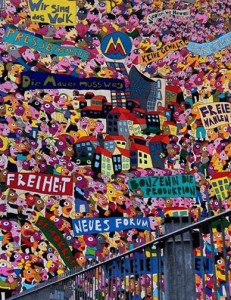 PhD proposals are invited on the following topics:
PhD proposals are invited on the following topics:
- the relationship between globalisation and the fall of state socialism;
- “1989” as a globally interconnected phenomenon;
- the global impact of the collapse of state socialism;
- the impact of the fall of state socialism on memory on a transnational, transregional or global scale;
- other innovative themes which place the fall of state socialism in global perspective.
Applicants wishing to work on any country, world region, or interconnections between regions, or on a global scale, are encouraged to apply. Proposals may address these themes from political, economic, cultural or social perspectives, and may draw their expertise from any discipline in the humanities or social sciences.
The successful candidate will be supervised by Professor James Mark, Principal Investigator with 1989 after 1989. The studentship is anticipated to start between May and September 2015 and is open to UK and EU applicants only. The award will cover tuition fees and provide an annual stipend of £13,863 for three years. More information on this PhD studentship and how to apply can be found on the University of Exeter’s PhD funding webpages.
In addition to this, a further PhD studentship is available on Professor James Mark‘s Arts and Humanities Research Council (AHRC) supported project Socialism Goes Global: Cold War Connections Between the ‘Second’ and ‘Third Worlds’ 1945-1991. This collaborative project brings together the Universities of Exeter, Oxford, Columbia, Leipzig and Belgrade, the Hungarian Academy of Sciences, and University College London to address the relationship between what were once called the ‘Second World’ (from the Soviet Union to the GDR) and the ‘Third World’ (from Latin America to Africa to Asia).
PhD proposals are invited on themes which address any political economic, cultural, or social aspect of this encounter, whether from the viewpoint of one region/country/ institution/group, or with a transregional approach incorporating the perspectives of multiple global actors. For an indication of some potential project areas, see the programme for the project’s first conference.
More information on Socialism Goes Global and how to apply can be found on the University of Exeter’s PhD funding webpages.
[Top]1989 after 1989 Research Fellow Awarded Fritz Stern Dissertation Prize
Posted on 9 December, 2014 in1989 after 1989 Human Rights

Many congratulations to our Research Fellow, Dr Ned Richardson-Little, on being awarded the prestigious 2014 Fritz Stern Dissertation Prize.
He received the award at the 23rd Annual Symposium of the Friends of the German Historical Institute in Washington DC last month, where Richardson-Little also spoke about his dissertation and his research.
 His PhD dissertation: Between Dictatorship and Dissent: Ideology, Legitimacy and Human Rights in East Germany, 1945-1990 (Ph.D. dissertation, University of North Carolina at Chapel Hill, 2013) was praised by the German Historical Institute (GHI) for being an “intellectually challenging and beautifully written study of human rights politics in the German Democratic Republic”. The GHI also commended his work for it’s significant and timely contribution to both historiography on modern Germany and the emerging scholarship on human rights.
His PhD dissertation: Between Dictatorship and Dissent: Ideology, Legitimacy and Human Rights in East Germany, 1945-1990 (Ph.D. dissertation, University of North Carolina at Chapel Hill, 2013) was praised by the German Historical Institute (GHI) for being an “intellectually challenging and beautifully written study of human rights politics in the German Democratic Republic”. The GHI also commended his work for it’s significant and timely contribution to both historiography on modern Germany and the emerging scholarship on human rights.
The GHI’s prize citation reads:
Edward Richardson-Little’s dissertation, “Between Dictatorship and Dissent: Ideology, Legitimacy, and Human Rights in East Germany, 1945-1990,” is an intellectually challenging and beautifully written study of human rights politics in the German Democratic Republic. Upon learning that leaders and supporters of the ruling Sozialistische Einheitspartei Deutschlands (SED) often invoked human rights, one might be tempted to imagine this practice as a cynical use of rhetoric by a dictatorial government to combat a rival Western vision of democracy and capitalism. However, Richardson-Little persuasively demonstrates that the SED and its supporters convinced many religious leaders, intellectuals, and working class supporters that socialism supported an indigenous brand of human rights superior to the individualistic, liberal version offered by the West. Richardson-Little makes excellent use of a wide range of sources from fourteen German archives to argue that, not only was there a thriving debate about human rights in East Germany, but also that citizens used that discourse to express dissent. Quite early, the SED developed its own Marxist conception of human rights to criticize the West, including the dangers of Western imperialism. The East German regime encouraged its citizens to believe that there could be “no human rights without Socialism.” The SED established a Committee for Human Rights, argued for human rights solidarity in the Third World, and used human rights as a basis for international agreements with the West. By the mid-1980s the discourse of human rights fostered by the SED provided peace activists, environmentalists, and advocates of democracy a powerful tool to oppose East German policies as well. The strength of their arguments helps explain the speed of revolutionary impulses by 1989. The SED’s use of human rights discourse, Richardson-Little demonstrates, played a critical role in legitimizing its own downfall. The topic of human rights has received a great deal of scholarly attention from recent historians, largely as part of narratives of the spread of Western values. However, as Richardson-Little points out, contradictions between a rhetoric of human rights and political policies that violate those rights characterized Western powers as well. Historians should be no less willing to accept that contemporaries in East Germany could value human rights, even if their envisioned path to achieving those rights varied significantly from their Western counterparts. In the face of continued debates about the limits of the West’s commitment to human rights, Richardson-Little’s Between Dictatorship and Dissent thus makes a significant and timely contribution, both to the historiography on modern Germany and to the emerging scholarship on human rights.
Richardson-Little will now continues his research with the 1989 after 1989 project at the University of Exeter, where he seeks to complicate the triumphalist narratives of good inevitably overcoming evil, ushering in a unified global human rights culture, by examining the complexity and plurality of human rights in late socialism and the post-socialist world. More information on Dr Richardson-Little research can be found here.
[Top]Transitional Criminal Justice in Post-Dictatorial and Post-Conflict Societies
Posted on 3 December, 2014 in1989 after 1989 Human Rights Transitional justice

Raluca Grosescu‘s co-edited volume “Transitional Criminal Justice in Post-Dictatorial and Post-Conflict Societies” is now available as part of Intersentia’s Series on Transitional Justice.
Edited alongside Agata Fijalkowski, a Senior Lecturer in Law at Lancaster University, the volume considers the important and timely question of criminal justice as a method of addressing state violence committed by non-democratic regimes. Its main objectives concern a fresh, contemporary, and critical analysis of transitional criminal justice as a concept and its related measures, beginning with the initiatives that have been put in place with the fall of the Communist regimes in Europe in 1989.
The collection argues for a re-thinking and re-visiting of filters scholars use to interpret the main issues of transitional criminal justice. Such things as: the relationship between judicial accountability, democratisation and politics in transitional societies; the role of successor trials in re-writing history; the interaction between domestic and international actors and specific initiatives in shaping transitional justice; and the paradox of time in enhancing accountability for human rights violations. In order to accomplish this, the volume considers cases of domestic accountability in the post-1989 era, from different geographical areas, such as Europe, Asia and Africa, in relation to key events from various periods of time. In this way the approach, which investigates space and time-lines in key examples, also takes into account a longitudinal study of transitional criminal justice itself.
Transitional Criminal Justice in Post-Dictatorial and Post-Conflict Societies will be available from Intersentia as part of their Series on Transitional Justice.
[Top]‘Death to fascism, freedom to expression!’ – The Post-Yugoslav Media and Freedom of Speech
Posted on 3 November, 2014 in1989 after 1989 End of Yugoslavia Human Rights

By Ljubica Spaskovska
The transition to democracy should have liberated the media in the former Yugoslav states, but in many ways the situation has actually gotten worse.
‘In these times/when everything is silent/In these times/I say – freedom/ And I see fear…’
This verse from the song entitled ‘Freedom’ is one of the tracks from an album by the Macedonian band ‘Reporters’ made up exclusively of journalists of different ethnic backgrounds. Under the slogan ‘Solidarity for freedom’, the Independent trade union of journalists and media workers, with the support of the US Embassy launched a campaign meant to incite a debate on freedom of speech, on the state of the media in Macedonia and solidarity among journalists. Over the past few weeks, both Macedonia’s and Serbia’s Independent Journalists’ Associations (members of the International Federation of Journalists) have raised concerns about similar phenomena through calls for a public hearing on media freedom or through the organisation of debates, conferences and concerts.
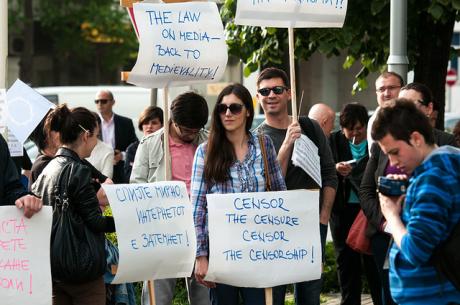
Indeed, the 2014 EU progress reports for all of the post-Yugoslav states aspiring to EU accession (Bosnia-Herzegovina, Montenegro, Serbia, Kosovo, Macedonia) underline a trend of serious deterioration of media freedom. Almost quarter of a century after the disintegration of Yugoslavia and the introduction of electoral, multi-party democracy, these societies have been witnessing a progressive narrowing down of public, intellectual and media spaces for free debate and reporting. Political and financial pressures, intimidation and threats against journalists and editors in Bosnia, self-censorship, threats and violence against journalists in Serbia, Montenegro and Kosovo, and government influence on media exercised through state-financed advertising in Macedonia have been observed in a context of a scarcity of real commitment on the part of political elites to tackle this problem and take the recommendations from the progress reports seriously.
Over the years, different governments have managed to blur the line between the ruling party/coalition and the state and to deprive state institutions of their independence. Moreover, they have turned an increasing number of media outlets into channels for dissemination of their political ideology or attacks on political opponents. For instance, the State Department Macedonia Country Report on Human Rights Practices for 2013 noted that members of the Association of Journalists of Macedonia reported pressures ‘to adopt a pro-government viewpoint in their reporting or lose their jobs.’
In Macedonia, further grievances were aroused by the detention and conviction of journalist Tomislav Kežarovski for revealing the identity of a protected witness in a story written in 2008. Civil society activists, local journalist associations and opposition leaders have constantly referred to reports by international bodies and governments that had condemned the trial and Kežarovski’s imprisonment in order to give legitimacy to their protest, albeit to little avail.
Moreover, the State Department Country Report lists Kežarovski’s case in the section entitled ‘Political Prisoners and Detainees’. The OSCE Representative for the Freedom of the Media, as well as the European Federation of Journalists similarly condemned the long sentence. Hence, it comes as no surprise that in the 2014 World Press Freedom Index Macedonia sits in 123rd place and has never been so low in the Index (the lowest in comparison to the other former Yugoslav states).
However, the state of the media is only a symptom of wider societal phenomena such as growing intolerance toward ‘oppositional’ voices and certain frozen narratives which seek to uncritically glorify the nation, the state, the ruling ideology and demonize the socialist/Yugoslav past. Croatia and Slovenia are the only two former Yugoslav republics which are members of the European Union. Although considerably higher on the World Press Freedom Index, neither Slovenia nor Croatia have been immune to the (re)establishment of a certain dogmatism in interpreting or discussing about the past.
A case in point is the recent decision of Croatian President Ivo Josipović to fire his main analyst professor Dejan Jović for an article in the academic journal Political Thought. Entitled ‘Only in myths every nation desires its own state’ and comparing the Scottish independence referendum and the Yugoslav referenda of the early 1990s, Jović argued that the latter were illiberal and did not allow for a genuine debate and consideration of all political opinions and visions for Yugoslavia’s future.
Similarly, the MPs of the conservative Slovenian Democratic Party (SDS) proposed a dismissal of the president of the Slovenian national assembly Dr. Milan Brglez for qualifying Yugoslavia in an interview as a state that had credibility and prestige in the international community and that the Slovenian independence in that sense was a step backwards.
Why, a quarter of a century after the first multi-party elections in the former Yugoslavia, are there still certain dogmatic ‘truths’ in most of the successor states, where freedom of expression is not an accomplishment, but, rather, something yet to be realised?
An obvious reason which is often evoked as the main factor is the socialist past itself. However, this can only offer a partial explanation and it could be counter-productive, as it fails to put the burden of responsibility on contemporary policy-makers and elites. Moreover, from 1950 practices of pre-censorship had been abolished in socialist Yugoslavia. It was the public prosecutor who could act only ex-post facto, after a broadcast, publication or film presentation. By the mid-1980s, the Yugoslav media network was significantly fragmented, decentralised, yet numerically impressive.
In 1987, Yugoslavia had 2,825 newspapers and 202 radio and TV stations. Hence, it was virtually impossible to sanction all acts which were classified as ‘verbal crime’ under the notorious ‘Article 133’ which criminalised acts of ‘hostile propaganda’, but was also meant to curb nationalist discourse, channelling what Lenard Cohen identified as ‘Yugoslav communism’s strong antipathy to overt nationalist tactics’.[1] Moreover, the 1980s saw the reinvigoration of the debate on freedom of speech and on the abolishment of the verbal crime. Although restrained, debate did occur in different fora.
For instance, in 1981 the president of the Federal Court in an article in a law journal acknowledged that the formulation of ‘Article 133’ was not precise, while at the 1983 conference of Yugoslav criminologists several professors of law called for the repeal of the article.[2] Several years later, as a young journalist in one of the principal magazines of the League of Socialist Youth, Dejan Jovic argued that the organisation (which in fact financed the magazine) should be abolished [3]. Back then, he was not sacked for his opinion.
Twenty-five years later, both old and new generations of journalists, intellectuals, students and activists are fighting battles which would have normally belonged to a distant past. When on 9 May last year, on the occasion of Europe Day, representatives of the ‘Front for Freedom of Expression’ gathering a number of civil society organizations and initiatives staged a protest in front of the seat of the delegation of the European Union to Macedonia, they chose as their slogan a creative remake of an old motto of the partisan resistance movement: ‘Death to fascism, freedom to expression!’.
References:
[1] Lenard Cohen, The Socialist Pyramid Elites and Power in Yugoslavia(Oakville/New York/London: Mosaic Press, 1989), p.445.
[2] Yugoslavia: Prisoners of Conscience (London: Amnesty International Publications, 1985), p.29.
[3] Dejan Jović, ‘Kad bi SSOJ postojao, trebalo bi ga ukinuti (1)’ Polet 402, 10.2.1989.
[Top]Introductory Seminar
Posted on 19 May, 2014 in1989 after 1989
Monday 2nd June, 3pm
Amory C417, Streatham Campus, The University of Exeter
Work began on the 1989 after 1989 project in January 2014 and the team of six researchers will be presenting their work at an Introductory Seminar on Monday 2nd June at 3pm in Amory C417. All are welcome to attend.
The team are particularly interested in promoting interdisciplinary research and creating links with those interested in understanding this moment of major political, economic and cultural transformation from different regional perspectives – Germany to Kazakhstan and from Latin America to sub-Saharan Africa.
The following research projects will be presented:
Dr Raluca Grosescu – Transitional Justice in Post-Dictatorial Eastern Europe and Latin America
Dr Nelly Bekus – The After-Life of the Socialist Legacy in Post-Soviet Capital Cities
Dr Ned Richardson-Little – Human Rights in the Global 1989
Dr Ljubica Spaskovska – The End of Yugoslavia as a Global Project
Anna Calori – Experience and Understanding of Economic Transformation in States in the Former Yugoslavia
For more information about this seminar please contact Natalie Taylor, Project Co-ordinator – N.H.Taylor@exeter.ac.uk
[Top]The Future of the Past: Why the End of Yugoslavia is Still Important
Posted on 31 March, 2014 in1989 after 1989 End of Yugoslavia

By Ljubica Spaskovska
A new socialist model is emerging in the western Balkans. Can its political vocabulary transcend the ethno-national dividing lines in the region?
‘New project for democratic socialism in Yugoslavia’ read the title of the resolution for the last congress of the League of Communists of Yugoslavia. It was January 1990.
As the Yugoslav Party was writing the last pages of its seventy-year old existence, few were left who believed in the viability of the project of democratic socialism. ‘The liberal utopia which underpinned 1989’ was the idealized way the socialist East and South imagined ‘the West’ and liberal democracy. In the aftermath of the last Yugoslav party congress, even fewer could imagine that ‘democratic socialism’ could ever be resurrected as a viable political project.
Almost a quarter of a century later, however, the Slovenian ‘Initiative for democratic socialism’, the Democratic Labour Party and the Sustainable Development Party have announced the establishment of a ‘United Left’ coalition. These non-parliamentary leftist groups will present their bid for a new socialist model in Europe at the upcoming EU elections in May. While the recent wave of protests in Bosnia-Herzegovina, and on a smaller scale in Macedonia, have raised social concerns and acted as a vent for rebellion against the political and economic mismanagement by elites, Kosovan students at the University of Prishtina made a strong case against structural corruption and fraud, eventually succeeding in deposing the Rector.
Many of those who found themselves at the forefront of these ‘acts of citizenship’ have been young people who came of age in the post-socialist period. The Kosovan student protesters, the Macedonian activists for social justice in the leftist groups ‘Solidarity’ and ‘Lenka’, the organizers of the Zagreb Subversive Forum, and the activists in the Slovenian Initiative for democratic socialism, belong in a pool of activists groups, initiatives or centres for research that espouse progressive politics while they have sought to deconstruct the ‘liberal utopia’ of the post-socialist period. They are unquestionably part of a new political generation (or, a ‘generation unit’, to use Mannheim’s terminology) whose political subjectivities, demands and visions represent a departure from those that twenty-five years ago ushered in the post-Yugoslav era.
How to account for this sudden post-Yugoslav outburst of social discontent and the resurrection of a long-forgotten vocabulary, where social rights, democratic socialism, the working class and the dispossessed feature rather prominently? Beside the generational factor, one possible answers lies in the concluding paragraph of last month’s open letter to the international community signed by 130 scholars and academics from around the world:
“In [the] spring of 1992, Bosnian citizens staged in Sarajevo the largest demonstrations ever against all nationalist parties. They were silenced by snipers, and their voices, from that point on, ignored by the international community. This time, the world should listen.”
Indeed, the conventional narrative of the 1980s, as the climax of political skirmishing and ethnic hostility, has so far managed to conceal a major stream of critique that was silenced by the subsequent armed conflicts and progressively erased in the new nation-states. The last Yugoslav public opinion survey conducted in 1990, from a sample of 4,230 adults, revealed clear divisions along lines of ethno-national belonging.
However, there was one part of the survey where Yugoslav citizens appeared strikingly unanimous. Namely, respondents were asked if expenditures on education, culture, healthcare and social security should be reduced. 74% of Bosnians, 66% of Montenegrins, 81% of Croatians, 71% of Macedonians, 72% of Slovenes, 79% of Serbs, 80% of Kosovans and 84% of Vojvodinians said this budget should be either increased or the present level of spending should be maintained. Moreover, the survey found that the ‘democratic optimism’, i.e. a support for a multi-party system was highest among Kosovans and Slovenes (19%) and lowest in Bosnia-Herzegovina (4%). Indeed, respondents from ethnically-mixed regions expressed fears that a multi-party system would exacerbate inter-ethnic divisions.
One of the spheres where many of these debates took place during the 1980s was the Yugoslav press and, in particular, the so far scarcely researched youth press. A commitment to exposing socio-economic structural inequalities and forms of corruption, especially among top Party officials, came to define the increasingly vocal youth press that was subject as a result to ongoing bans, trials and public discrediting throughout the 1980s. This led foreign scholars to observe that:
“Of all the periodical publications appearing in Yugoslavia, it is the youth press which has proven the most consistently nettling to the authorities. Outspoken to the point of rebelliousness, the young editors […] have repeatedly ignored even the most fundamental taboos”.
Pedro Ramet, ‘The Yugoslav Press in Flux’, in Pedro Ramet (ed.) (1985), Yugoslavia in the 1980s, p.111
Young journalists tended to link these phenomena to the authoritarian traits of Yugoslav socialism, in particular the Party’s elites and their monopoly on power. In December 1984, for instance, the Croatian youth magazine Polet published an ironic call for the ‘Big, bigger, the biggest Yugoslav competition for the photograph of the most beautiful, richest, most luxurious and most unavailable house for the working class on the territory of the former Yugoslavia’, printed over a black and white photo of a big mansion. It also noted that ‘precedence will be given to the photographs which will also supply information about the location, the size, the owners and their occupation’. Four years later, the main Bosnian youth magazine Naši dani was at the helm of a big public debate which exposed the practice of building summer villas by high Bosnian political officials at the sea-side resort of Neum. One article unreservedly attacking high-ranking politicians put forward demands which could be heard in a modified form at recent protests: ‘To nationalise what had been robbed. To take away once and for all from the red bourgeoisie and give to the working class’. Finally, a similar affair burst into the open when Slovenian youth magazine Mladina accused the federal Minister of Defense of having a summer villa constructed for himself by army recruits in the sea resort of Opatija.
As the decade drew to a close and the Yugoslav sonderweg led many to believe that the multi-level crisis was a dead-end street and that violence was looming, many voices warned at the prospect of elites capitalizing on social discontent and posing as national saviours. Even regions like Macedonia, which were later spared from the violence of the dissolution conflicts, were mired in a new nationalist rhetoric and calls for prohibition of ethnic minorities’ political parties. The way the editor-in-chief of the youth magazine Mlad borec, Nikola Mladenov targeted the rise of nationalism in his editorials, both at Yugoslav and local level, captures this:
“As if it became a civic duty to propagate national tragedy and vulnerability. In place of one collectivity – the class, we are being offered another one – the nation, the easiest way of manipulating the emotions of tomorrow’s voters. The propagating of one’s one history – always the most bloody and most difficult – hasn’t bypassed us either […]”
For two and a half decades former Yugoslavs were repeatedly reminded of their national tragedies, bloody histories, or their victimhood at the hands of neighbours. They were encouraged, if not forced, to erase out of their memories and identities that other collectivity – the class. What the Bosnian student magazine Valter wrote in 1990 indeed reads like a prophecy:
“We should not have any doubts that this is a period where we’ll see a formal change of government, accompanied by strong disillusionment of manipulated voters. Because exclusive anti-communism does not imply automatic creativity; on the contrary, the motives are quite banal and easily recognisable – taking power.”
A generational shift, growing inequality, deterioration in living standards and the withering away of social rights have undoubtedly proved crucial for the emergence of a new political vocabulary and a range of demands which appear to neglect, if not transcend, the ethno-national frame. However, it remains to be seen whether the social(ist) utopia that underpins this shift is going to successfully restore some of the betrayed hopes of the late 1980s.
Bibliography:
George Lawson, Chris Armbruster and Michael Cox (eds.), The Global 1989: Continuity and Change in World Politics (Cambridge University Press, 2010).
Ljuljana Baćević, et al. Jugoslavija na kriznoj prekretnici (Beograd: Institut društvenih nauka/Centar za politikološka iztraživanja i javno mnenje, 1991).
Pedro Ramet, ‘The Yugoslav Press in Flux’, in Pedro Ramet (ed.), Yugoslavia in the 1980s (Westview Press, 1985), p.111.
‘Veliki, veći, najveći’, Polet 292, 21.12.1984, p.10.
Radmilo Milovanović, ‘Neum ili dolje crvena buržoazija’, Naši dani 949, 2.9.1988, p.7.
Nikola Mladenov, ‘Народе македонски’, Mlad borec 1971, 07.03.1990.
Goran Todorović, ‘Sveti Ante’, Valter 28, 17.4.1990, p.2.
Writing Human Rights into the History of State Socialism
Posted on 24 March, 2014 in1989 after 1989 Human Rights

By Ned Richardson-Little

One of a number of East German postage stamps commemorating International Human Rights Year 1968. The hammer and anvil represent the right to work
The collapse of the Communist Bloc in 1989-1991 is viewed as one of the great triumphs of the human rights movement. But this ignores how socialist elites of the Eastern Bloc viewed themselves: not as the villains in the story of human rights, but as the champions.
In recent years, the rapidly expanding field of human rights history has done much to complicate triumphalist narratives of inevitable victory for Western liberal democracy over the forces of tyranny. Recent collections including those edited by Stefan-Ludwig Hoffmann, Jan Eckel and Samuel Moyn, have opened up new lines of inquiry exposing not only the contingency of these ideas, but also the conflicts amongst those claiming the mantle of universal human rights. On the Exeter University Imperial and Global History Centre blog in recent weeks, Fabian Klose has examined the important role of decolonization and post-colonial states in shaping the development of human rights politics, and Robert Brier has interrogated the idea of human rights as a product of neo-liberalism in the context of the Polish opposition. Here, I want to look beyond the human rights campaigns of dissident Eastern Europeans to that of the states they fought against.
While state socialism is normally seen as the definitional opponent of human rights – rejecting individual autonomy, independent justice, free elections, free speech and free practice of religion – the elites of the Eastern Bloc claimed that they were actually the true representatives of human rights. For them, the revolutionary victory over capitalism meant the end of class conflict and the abolition of the “exploitation of man by man.” The creation of a socialist society overcame the horrific abuses of the capitalist system, including war, imperialism and racism.
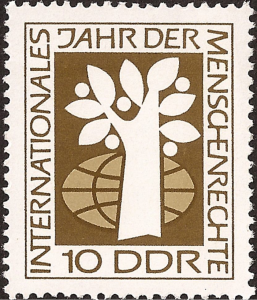
Another stamp commemorating International Human Rights Year 1968. The tree and globe represent the right to life
Eastern Bloc elites built upon Karl Marx’s denunciation of human rights rhetoric as a tool of the bourgeoisie to disguise their own class interests in the cloak of universal justice. They argued that while human rights were indeed a sham under capitalism, the socialist revolution had created a higher kind of human rights that allowed for real participation in all forms of political and economic life and achieved true equality across the class, race and gender lines. As the East German legal philosopher Karl Polak declared, “There can be no human rights without socialism!”[1]
When such rhetoric from the Eastern Bloc has been noted in histories of the Cold War, it is usually dismissed as a crude and cynical attempt to deflect Western criticism, particularly after the signing of the Helsinki Accords in 1975. That is, once the communist states were compelled to affirm the idea of human rights, they simply had to adjust their rhetoric in a desperate attempt to fend off protest from within and without.[2] These narratives are undermined, however, by the fact that state socialist elites were using the language of human rights well before Helsinki – the quote above from Karl Polak dates to 1946. In Hungary, the first scholarly work on human rights and socialism was written by legal scholar Imre Szabo in 1948.[3] As Jennifer Amos and Daniel Whelan have demonstrated, the Soviet Union was an active player in the human rights diplomacy of the 1950s. Such early efforts weren’t just rhetorical or academic: the German Democratic Republic formed the Committee for the Protection of Human Rights to campaign against abuses by the West and to mobilize citizens to campaign against the imprisonment of communists and peace activists in West Germany. Founded in 1959, this group predates the creation of Amnesty International by two years.
The 1970s are today seen as the turning point when international human rights exploded as a global movement, but at the beginning of the decade, it appeared to some observers that the West was simply outmatched by the Socialist Bloc. By 1968, the entirety of the Eastern Bloc had either signed or publically affirmed the UN’s International Covenant on Civil and Political Rights. While the United Kingdom, Italy, and West Germany did so early on, other Western countries lagged well behind with Canada signing in 1976, the USA in 1977 and France in 1980. In 1973, one observer from West Germany concluded,
With the change in majorities in the bodies of world organizations – particularly in the [UN] General Assembly – the socialist states have recognized the possibility of the politicization of human rights, and the free world has almost cleared off the field without a fight: the US by its human rights abstinence, the Western European countries by their regionalism.[4]
While the Helsinki Accords are now often portrayed as a coup for the West in “forcing” the East to accept terms that would eventually lead to its downfall, at the time, the idea of human rights was hardly seen as a devastating ideological weapon.
Including the perspective of state socialist leaders and elites is crucial to understanding human rights diplomacy in the post-war era. Such ideas and politics also were crucial to state socialist rule and influenced the development of dissident and opposition movements, as I have recently argued, along with Benjamin Nathans, Paul Betts, and Mark Smith and others. Celia Donert’s recent work similarly demonstrates how the explosion of women’s rights as human rights in 1990s can be in part traced back to the transnational feminism organized through Eastern Bloc organizations and events that have been dismissed as mere propaganda for communism. Rather than simply seeing the rise of human rights movements in the East as a direct importation from the West, this new scholarship shows how 1989 was also connected to the evolution of indigenous right cultures that were initially fostered by the state. This line of inquiry is not only valuable to the study of the Cold War and its end, but also to explaining the development of human rights politics in the post-socialist period.
In challenging liberal Western triumphalism, it is also vital to consider the perspectives of the socialist East. The appropriation of the idea of human rights by non-liberal and even dictatorial states is no relic of Cold War dynamics long since departed, but is continuing to this day in Iran and North Korea. In grappling with the developments of 1989, political scientist Peter Juliver argued that one had to begin a process of “rethinking rights without the enemy.” I would argue that in order to do so, we first must rethink the history of human rights including the “enemies,” and not just the victors.
[1] Karl Polak, “Gewaltteilung, Menschenrechte, Rechtsstaat: Begriffsformalismus und Demokratie,” Einheit 7 (December 1946): 138.
[2] For the main work asserting the discontinuous effect of Helsinki Accords for the Eastern Bloc, see Daniel Thomas, The Helsinki Effect: International Norms, Human Rights, and the Demise of Communism(Princeton UP, 2001) as well as Michael Ignatieff, Human Rights as Politics and Idolatry, University Center for Human Values series (Princeton UP, 2001), 19, which argues that the Eastern Bloc denied the validity of political and civil human rights prior to Helsinki.




